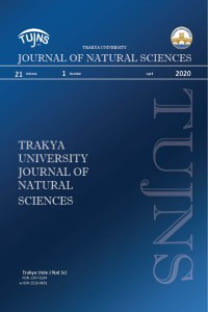DISTRIBUTION OF Ambrosia artemisiifolia L. IN THE RIGHT-BANK FOREST-STEPPE OF UKRAINE AND ITS ADAPTIVE POTENTIAL
DISTRIBUTION OF Ambrosia artemisiifolia L. IN THE RIGHT-BANK FOREST-STEPPE OF UKRAINE AND ITS ADAPTIVE POTENTIAL
Drought resistance light requirement, soil fertility, vegetative reproduction, seed reproduction, shoot regeneration,
___
- 1. Anderson, O., Vikhrenko, M., Cherninsky, A. & Myus, S. 2019. Biology and ecology: textbook for 11th grade institutions of general education: standard level. Kyiv: Shkolyar, 216 pp.
- 2. Besh, L., Vorobets, N., Novykevich, S., Kalynovich, N. & Svidrak, K. 2011. Features of seasonal allergy in children of western Ukraine from the point of view of an airobiologist and clinician. Problems of Clinical Pediatry, 3: 42-46.
- 3. Bezruchenko, N. & Chukorin, N. 1956. About sagebrush ambrosia (Ambrosia artemisiifolia L.). Botanical journal, 41(5): 712-713.
- 4. Bilyavskyi, S. 2011. Ambrosia artemisiifolia L. as part of the urban flora of the city of Bila Tserkva. Plants and urbanization. 35-36 pp. Paper presented at the Second international scientific and practical conference “Plants and urbanization”. 29-30 November, Dnipropetrovsk: LLC TVG “Kunitsa”.
- 5. Bilyavskyi, S. 2021. Quarantine and invasive plant species in the urban flora of Bila Tserkva. “Plant Conservation in the Face of Climate Change and Biological Invasionsˮ. 152-156 pp. Paper presented at the Proceedings of the International Scientific Conference. March 31, Bila Tserkva: LLC “Bilotserkivdruk”.
- 6. Brandes, D. & Nitzsche, J. 2007. Ecology, distribution and phytosociology of Ambrosia artemisiifolia L. in Central Europe. Tuexenia, 27: 167-194.
- 7. Burda, R. 1982. Urban flora of the Donetsk-Makeevka complex. 11 p. Paper presented at the 7th Congress of the Ukrainian Botanical Society: Abstracts of the report, Kyiv: Naukova Dumka.
- 8. Burda, R. & Ignatyuk, O. 2011. Methodology for studying the adaptive strategy of alien plant species in an urbanized environment. National Technical University of the National Academy of Sciences of Ukraine, CJSC “Vipol”, 112 pp.
- 9. Chemerys, I. & Konyakin, S. 2013. Analysis of the state of ragweed in the urban ecosystem of Cherkasy. Scientific notes of the Ternopil National Pedagogical University named after Volodymyr Hnatyuk. Series: biology. 1: 21-29.
- 10. Denisyk, G. & Kravtsova, I. 2012. Garden and park landscapes of the Right Bank forest-steppe of Ukraine. Vinnytsia: PP Edelweiss and K, 211 pp.
- 11. INaturalist. 2008. https://www.inaturalist.org/home (Date accessed: 7 July 2020).
- 12. Fisyunov, A., Makodzeba, I., Kozenko, V. & Shamkyi, I. 1970. Quarantine weeds and their control, Dnipropetrovs'k, 152 pp.
- 13. Friedman, J. & Barrett, S. 2011. Genetic and environmental control of temporal and size-dependent sex allocation in a wind-pollinated plant. Evolution, 65: 2061-2074.
- 14. Leiblein-Wild, M., Kaviani, R. & Tackenberg, O. 2014. Germination and seedling frost tolerance differ between the native and invasive range in common ragweed. Oecologia, 174: 739-750.
- 15. Maryushkina, V. 2006. Ambrosia artemisiifolia: methods of examination and control (Methodological recommendations), Kiev: Kolobig, 56 pp.
- 16. Neilyk, M. & Tsytsyura, Ya. 2020. Ambrosia artemisiifolia L.: systematics, biology, adaptive potential and control strategy. Vinnitsa National Agrarian University, Print Plus LLC, Ukraine, 700 pp.
- 17. Neilyk, M. 2008. Herbological monitoring of agrobiocenoses and features of the spread of ragweed in the Vinnytsia region. Fodder and fodder production, 60: 79-82.
- 18. Onipko, V. 2016. Phytocoenotic effectiveness of crop suppression of cultivated plants as a factor in biological control of Ambrosia artemisifolia L. (Asteraceae). Biology and ecology, 2(1): 31-37.
- 19. Palamarchuk, O., Rodinkova, V. & Dubuske, L. 2012. A Recent Significant Increase in Ambrosia Pollen Abundance in Central Ukraine. Journal of Allergy and Clinical Immunology, 129: AB92.
- 20. Pokotylo, V. & Pospelov, S. 2020. Ragweed: peculiarities of biology and ways to limit harmfulness, 102-106. Protection and quarantine of plants: history and present, 24-25 November, Poltava.
- 21. Protopopova, V. 1991. Synanthropic flora of Ukraine and ways of its development. Kyiv Naukova Dumka, 204 pp.
- 22. Pruntsev, S. & Asmolov, V. 2006. Evil blockage of lands. Quarantine and plant protection, 8: 18-21.
- 23. Rodinkova, V., Mazur, O., Slobodianiuk, L. & Motruk, I. 2012. Analysis of seasonal and daily dynamics of Ambrosia pollen distribution in the air of Vinnytsia region. Bulletin of Vasyl Stefanyk Precarpathian National University. Series Biology, 17: 49-52.
- 24. Sang, W., Liu, X. & Axmacher, J. 2011. Germination and emergence of Ambrosia artemisiifolia L. under changing environmental conditions in China. Plant Species Biology, 26(2): 125-133.
- 25. Shorthouse D. SimpleMappr, an online tool to produce publication-quality point maps. 2010. (Date accessed: 7 July 2020).
- 26. Solonenko, V. 2011. Distribution of ragweed (Ambrosia artemisiifolia L.) in Vinnitsia city. Collection of scientific papers of VNAU, 7: 88-96.
- 27. Zavialova, L., Protopopova, V., Kucher, O., Ryff, L. & Shevera, M. 2021. Plant invasions in Ukraine. Enviromental & Sjcio-economic Studies, 9(4): 1-13.
- 28. UkrBin. 2017. https://www.ukrbin.com/ (Date accessed: 10 March 2020).
- 29. Weather & Climate https://www.pogodaiklimat.ru/history/ (Date accessed: 10 October 2021).
- ISSN: 2147-0294
- Yayın Aralığı: 2
- Başlangıç: 2000
- Yayıncı: Trakya Üniversitesi yayınevi
MISLEADING METRICS: PREDATORY TRADE EXPANDS
AN EVALUATION OF SYLVIIDAE SPECIES IN THE TRANSPORT OF POLLEN: A CASE STUDY OF İSTANBUL
Nurgül KARLIOĞLU KILIÇ, Ergün BACAK, Rüya YILMAZ DAĞDEVİREN, Arif Cemal ÖZSEMİR, Elif Ayşe YILDIRIM, Umut GÜNGÖR, Vedat BEŞKARDEŞ
IDENTIFICATION OF LENS CULTIVARS IN MARKET BY MOLECULAR TOOLS: DNA BARCODING AND SSRs
Metin Burak TATLISES, Semra HASANCEBİ
Vladyslav PARAKHNENKO, Volodimir VİTENKO, Inna DİDENKO, Sergiy KOVAL, Vitalii CHERNYSH
Sergii ROGOVSKYI, Liubov ISHCHUK, Halyna ISHCHUK
Delastria, A NEW GENUS OF HYPOGEOUS FUNGI RECORD FOR THE TURKISH MYCOBIOTA
Ilgaz AKATA, İsmail ŞEN, Ergin SAHİN, Bekir ÇÖL, Emre KESKİN
ISOLATION OF A NOVEL ANTIMICROBIAL POLYPEPTIDE FROM AN Aspergillus niger ISOLATE
Ayşe ÜSTÜN, Ayşenur YAZICI, Serkan ÖRTUCU
Çağla ERSÖZ, Deniz ALTUN ÇOLAK
Gamze GÖGER, Esma ÇEVİK, Alişan VARNALI, Ömer Koray YAYLACI, Medine Münevver UMA, Gülmira ÖZEK
